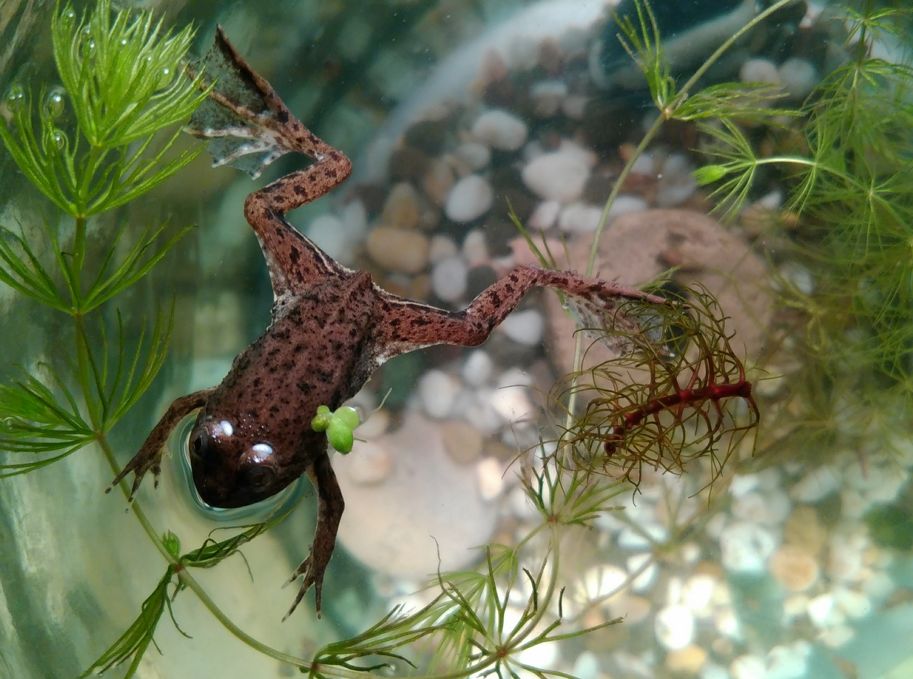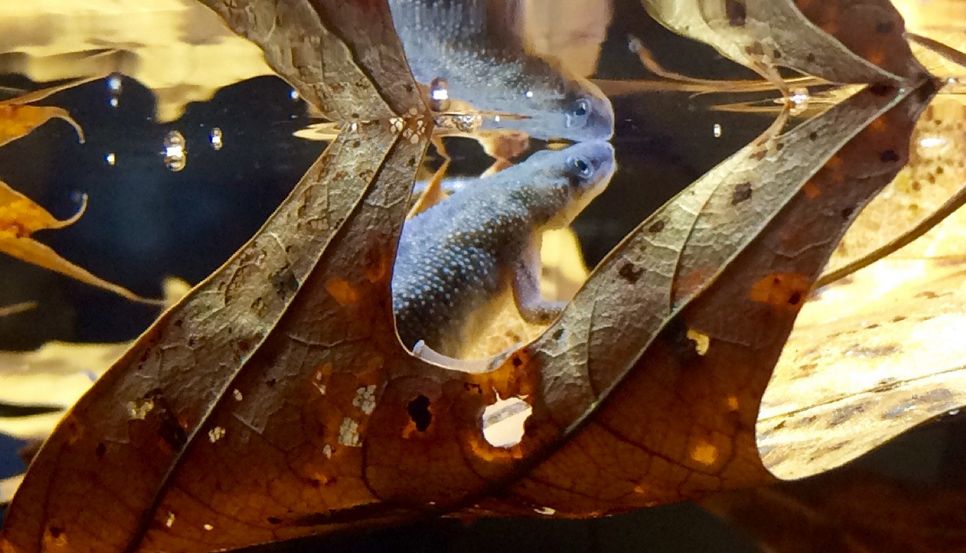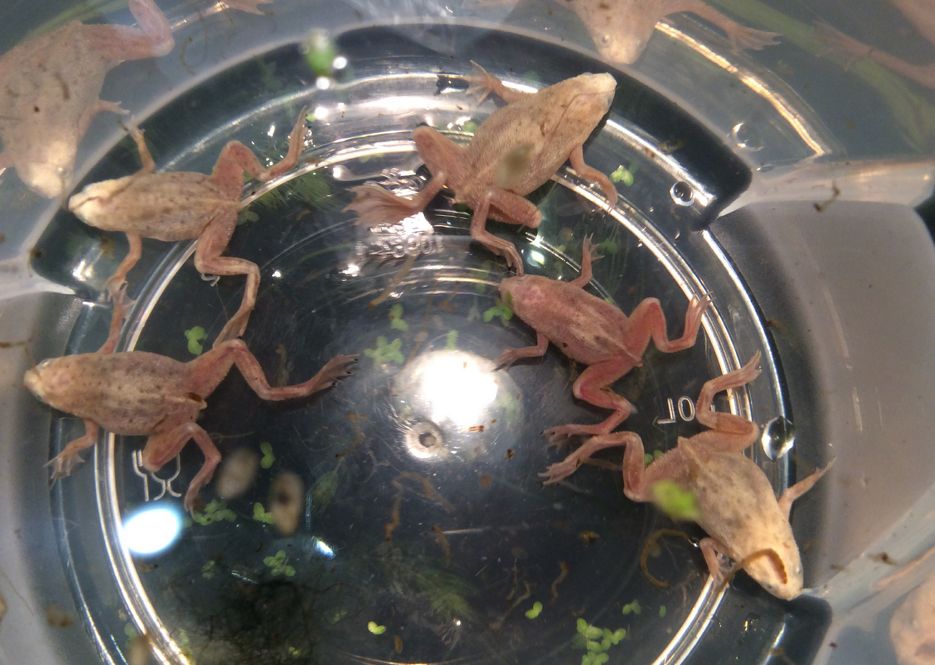African dwarf frog (lat. Hymenochirus) is a small and peaceful frog, that is more and more often encountered in tanks. Hymenochirus is a real water frog that can spend all its life without going to dry land. There are 4 different kinds of frogs in this family. But they have similar behavior and requirements for keeping, so in the article we’ll give a general description true for all of them.

Contents
Habitat in the wild
Birthplace of these small amphibian is in African equatorial forests – Nigeria, Zaire, Cameroon, Kongo. Usually the african dwarf frogs dwell in shadowed lowlands of slowly flowing rivers, bogs and puddles. These frogs live in water all the time and they don’t go out to dry land. However, they rise to water surface to breathe some fresh air.
They differ from other representatives of Pipidae family because they have webbed fore feed. Due to this fact the african dwarf frogs got its Latin name: the word Hymenochirus can be translated as ‘webbed feet’ or ‘the one with leathern feet’.
Description
Is a very small frog, the adult african dwarf frog species length doesn’t exceed 3.5-4 cm (1,38-1,57 inches). They becomes reproductive at the age of 12 month old and its lifespan can be about 5 years (or sometimes more).
The african dwarf frog is very graceful: it has long body, thin limbs, sharpened snout with nostrils at its end and this creature looks really tiny. African dwarf frog is dark gray or brown and gray colored. There are some black spots scattered over its body and not so many of them are on its light colored abdomen.
| Scientific Name | Hymenochirus |
| Common Name | African dwarf frog |
| Tank size | 25 liters (5.5 gallons) and more |
| Temperament | Peaceful |
| Diet | Omnivorous |
| Temperature | 72°F- 78°F (22 to 26 °C) |
| pH | 6.0-7.8 |
| Size | up to 3.5-4 cm (1,38-1,57 inches) |
| Lifespan | up to 5 years |
Difficulties in keeping
This is a small, peaceful and undemanding species. Recently, it has become quite popular and this is almost the only kind that can be kept in a tank. Other frogs are larger and more aggressive; to keep them successfully they require a possibility of going out to dry land (for example, African clawed frog or xenopus).

Care and keeping in a tank
Water parameters
To keep african dwarf frog successfully you’ll need a tank with water of medium hardness and pH within the range of 6,5-7,8. Like all amphibians this frog is cold-blooded and that’s why its metabolism doesn’t depend on the external temperature.
In the wild lives in small puddles and bogs with easily warmed and not always clean water. Correspondingly, they also prefer to have warm water in a tank – not less than 20 (68 °F), but 24 °C (75 °F) is even better. If the african dwarf frog is kept in cold water it’s more prone to various diseases.
Optimal water temperature is 22 – 25 °C (71,6-77 °F), but this they can successfully stand even more significant changes. Tank water parameters should be the following: pH 6.5-7.8, gH 5-20, kH 4-15.
Due to the soft and spongy skin, it is very sensitive to chemicals of any type. For the same reason it’s not recommended to take them into hands.
Tank decor
For one or two couples a tank from 25 liters (5.5 gallons) capacity is enough.
You can use gravels as tank bottom substrate, but is has to be rounded and large enough to make sure that the african dwarf frog won’t swallow it with food. Sandy bottom or river stones 3-5 mm in diameter put on the bottom is also a good idea.
This frog doesn’t require any dry land, it can spend all its life in water without any discomfort. However, yet it needs rising to water surface from time to time to breathe. They can’t stay out of water for longer than 10-15 minutes, after this time they suffer from dehydration and die.
However, this doesn’t mean that the african dwarf frog can’t leave the tank of its own free will. Sure it can! You should close tightly a tank, but they must have free access to atmospheric air.
It is desirable to create slow water flow in the tank, but the filter shouldn’t be too powerful. We recommend to put foam plastic or a net with small apertures on leading-in tube of the filter to make sure that thin limbs won’t get there.
The african dwarf frog is not demanding in terms of water quality. As for frequent water renews, they are not required and, moreover, they are unwanted. These lentic water dwellers don’t like strong water flow (from a powerful filter, for example). At the same time water aeration is desirable, but there should be some tank corner with lentic water.
Young african dwarf frogs are active swimmers, but sometimes they like to lie down on floating plants. If they want to have some sleep or to have rest, they sit on tank plants or swim on the water surface. Hymenochirus gladly hides under large plant leaves, snags and stones.
As for the tank plants you should put large leaved ones with strong roots and put some stones above their roots, because frogs like digging the plants.
African dwarf frog gets oxygen not only through its lungs, but partially through its skin. Dermal respiration composes about 1/3 from total breathing volume when the frog is at rest and only 1/10 when the frog is active.
At that every several weeks as the african dwarf frog grows it sheds skin. To do this they make intense rotatory motions that look like they toss and turn and very often after shedding they eat their skin. If they didn’t, it’s better to remove it from the tank the next day.

Feeding
Any kind of live food used for fish will do for african dwarf frog (daphnia, tubifex etc.). As for the bloodworm you can give it once or twice is a week, since it has low protein content and it doesn’t contain many vital and irreplaceable amino acids.
As any amphibian these frogs respond to movement, that’s why they don’t eat motionless food eagerly. Nevertheless, some aquarists manage to feed only with frozen or even artificial food. However, Hymenochirus is a real predator at all stages of its life.
This species don’t chew their food, they gasp the food and gradually swallow it. They doesn’t have neither teeth nor tongue, that’s why it needs food small enough to eat it at once or that can be milled by the frog by grinding up movements.
You should feed once in 2-3 days. If these frogs live together with other fishes in a community tank, you have to keep an eye on how they feed and make sure that they aren’t hungry.
Fishes are much faster than the african dwarf frog, because it sees and catches its prey when it moves. Due to the peculiarities of the frog’s eyes location (they are on opposite sides of its head and very far from each other) and that’s why its vision is directed frontwards. For this reason it’s very difficult for the frog to see something near it or directly in front of it. So, to find food frogs use their smell and sense of touch.
Very often you may see them groping after food on the tank bottom and they miss it quite a lot of times! Sometimes looking for food may take the african dwarf frog from three to five minutes till it finds that there is some food in a tank.
Tank mates
African dwarf frog get on well with fishes of similar size. Considering their slow temper and small size they may eat small fishes and juveniles. This is an omnivorous predator, though it is small.
African dwarf frogs are compatible with Amano shrimp, red cherry, glass shrimp. However, they aren’t compatible with large crawfish, cichlids (Texas cichlid, convict cichlid, flowerhorn). It’s better to keep these frogs together with peaceful fishes such as betta fish, swordtail, platy.
Breeding
African dwarf frog breeding doesn’t have any fundamental differences if compared with most of tank fishes breeding process. The process is stimulated by raising water temperature up to 26-28 °C, increasing lighting level (as the photoperiod increases) as well as by renewing part of the tank water.
Water level in a spawning tank shouldn’t be less than 20 cm, which is stipulated by mating behavior. Couple swims if vertical circles in the water – this behavior is peculiar for many tongueless species.
The eggs have jelly-like shells and float on the water surface. Usually the frog lays about 50-200 eggs (up to 500). After the spawning is over, it is better to remove the couple from the spawning tank.
In 1-2 days black larva about 3 mm long hatch from the eggs. For several days they stay stick to the tank plant leaves and tank walls, or hover in the water surface layer.
Once the larva start to swim and you should begin to feed them. There are no differences in terms of feeding larva if compared with tank fish juveniles. Start feeding them with infusorian; and in about a month the metamorphosis occurs.